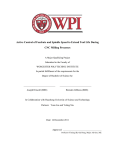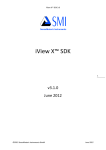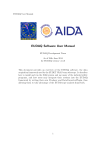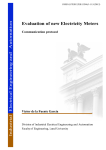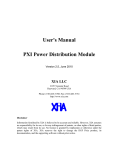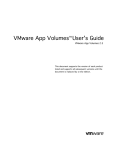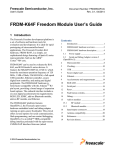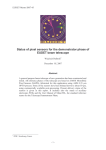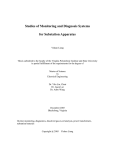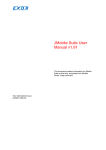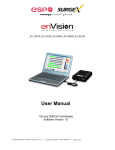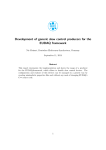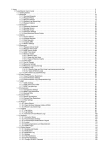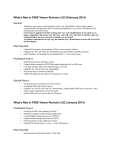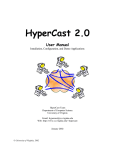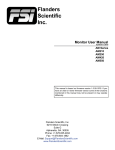Download Implementation of a Finite State Machine for the EUDAQ
Transcript
Implementation of a Finite State Machine for the
EUDAQ framework
Beryl Bell, Hampshire College, United States
September 8, 2015
Abstract
EUDAQ is a C++ based generic data acquisition framework(DAQ), usable across
various platforms. Runtime errors have been occurring during the use of the
software. These issues are rooted in a failure of the EUDAQ software to adhere to
a finite state machine. Thus the software can exist in states that are undefined by
the assumed finite state machine. For instance the program could be run before all
of its producers were configured. The object that tracks the state of the producers
in the original EUDAQ framework was located, determined to the insufficient. An
adjustment of this state tracking is made by creating two new classes that were
added and implemented for the finite state machine branch of EUDAQ.
1
Contents
1 Introduction
2 EUDAQ Framework
2.1 Class Hierarchies . . . . . . . . .
2.2 Transmission Control Protocol . .
2.3 Status Class . . . . . . . . . . . .
2.4 Finite State Machine For EUDAQ
2.5 Status Class as State Tracker . .
3
.
.
.
.
.
.
.
.
.
.
.
.
.
.
.
.
.
.
.
.
.
.
.
.
.
.
.
.
.
.
.
.
.
.
.
.
.
.
.
.
.
.
.
.
.
.
.
.
.
.
.
.
.
.
.
.
.
.
.
.
.
.
.
.
.
.
.
.
.
.
.
.
.
.
.
.
.
.
.
.
.
.
.
.
.
.
.
.
.
.
.
.
.
.
.
.
.
.
.
.
.
.
.
.
.
.
.
.
.
.
4
4
7
8
10
11
3 MachineState and ConnectionState Class
12
3.1 Implementation ConnectionState Class . . . . . . . . . . . . . . . . . . . 12
3.2 Implementation of MachineState . . . . . . . . . . . . . . . . . . . . . . . 13
3.3 Modification of GUI . . . . . . . . . . . . . . . . . . . . . . . . . . . . . 15
4 Backward Compatibility
15
5 Moving Forward
16
5.1 Transition States . . . . . . . . . . . . . . . . . . . . . . . . . . . . . . . 16
5.2 Error Handling . . . . . . . . . . . . . . . . . . . . . . . . . . . . . . . . 17
6 Summary
18
Appendices
19
2
1 Introduction
EUDAQ is a data acquisition framework. Conceivably this framework could be used in
any number of data acquisition projects. The framework is written for and tested on the
EUDET Pixel Telescope, but can be used for many di↵erent devices. EUDAQ is written
in C++ using the Qt libraries for its graphic interface and is structured in a such a way
that the framework can be used on Windows, Mac OS X, and Linux.
The framework is built in such a way that the writing of additional software for new
devices that one wishes to add to their system is straightforward. One simply needs to
extend the preexisting producer class and override all required methods. EUDAQ takes
care of the remaining setup.
EUDAQ goes through several steps to begin its data acquisition. Ideally these steps
are in the order: Connection of Devices, Configuration of Connected Devices, Run Data
Acquisition, Stop, Adjust Configuration, repeat. However, the framework should still
function even when the steps are not always precisely in this order. Thorough use of
the framework has reveled a number of situations in which the software fails because the
steps are not performed in the presumed order.
One of the steps in which the original EUDAQ was failing was during the run step of
the of the devices. The original EUDAQ software allowed a user to start a run without
configuring all their connections. Di↵erent devices have di↵erent configuration routines.
Configuration is one of the processes that must be defined during the extension of the
producer class. Some producers require variables to be set. Others need to perform specific configuring commands on the connected devices. Users were experiencing a failure
of the framework when they were able to perform a run before the devices were properly
configured. Undefined states are a symptom of the EUDAQ software not adhering to
a Finite State Machine(FSM). These undefined states allowed for the user to perform
actions before the program was ready to perform them.
In the original EUDAQ software states such as OK and OK:CONFIGURED are displayed in the main Run Control GUI and updated automatically. By starting at the
top panel of the run control this state was tracked to the class that was keeping track of
certain levels. The investigation of this error lead to the need for several modifications
of the way that the state was being tracked in the EUDAQ framework and specifically
in the producers. This modification prompted us to break the backwards compatibility
of the EUDAQ software so as to require the future producers to properly implement
FSMs.
3
2 EUDAQ Framework
EUDAQ has tiers of background processes that facilitate the functionality of state tracking. These background classes will contain the bulk of the modifications that constitute
the di↵erence between the original EUDAQ software and fsm branch of EUDAQ. The
various class hierarchies are addressed, as well as the specific transport protocol used
for data collection and logging. The class that should define the state of the machine,
called Status, is explored and traced throughout the EUDAQ framework.
2.1 Class Hierarchies
Figure 1: CommandReceiver Hierarchy
CommandReceiver The CommandReceiver class is the template for all classes that
are required to either send or receive information at any point during the run time. This
means that not only all the LogCollectors, DataCollectors, and Monitors inherit from
this class, but so does any producer. In order to acquire data from a new producer a
class specifically for that producer must be extended from the Producer class. As we
can see in Figure 1 , the producer class inherits from the CommandReceiver class, as
does the DataCollector, LogCollector, Monitor, and RunListener. Modification of the
base class CommandReceiver will prove an essential tool for propagating changes over
all executables connected to EUDAQ.
Additionally, the CommandReceiver keeps an instance of Status. In the original program the Status class was responsible for keeping a redundant copy of log messages that
were being handled by the EUDAQLOG system, which is the logging system that takes
messages from the entire system and displays them in the logger. This redundancy will
be addressed when the EUDAQ structure is modified for more appropriate state tracking.
RunControl The RunControl hierarchy represents the interface through which the user
interacts and controls the connections to the EUDAQ framework. Every class that inher-
4
Figure 2: RunControl Hierarchy
its from CommandReceiver communicates directly with the RunControl. As is shown in
Figure 2 the RunControl class is at the top of this hierarchy. This implements functions
to send and receive commands as well as receive packets from the various CommandReceivers.
The RunControlConnectionDelegate handles the display of the connections and their
states on the front panel of the RunControlGUI. In order to do this the RunControlModel
keeps a vector of objects called RunControlConnections. These RunControlConnections
have an instance of the Status class and an instance of the ConnectionInfo class. These
two variables are kept updated by the main RunControl and so they always accurately
represent what status has been logged by the status class and what the state of the
connection is.
Figure 3: TransportBase Hierarchy
TransportBase The TrasportBase hierarchy is essential to understanding how data
and commands are sent from the producers connected to the EUDAQ framework to
the main RunControl. The TransportBase hierarchy branches between server and client
classes as is showed in Figure 3. Both the Transport Client class and the Transport
Server class inherit directly from the TransportBase class. These classes are then fur-
5
ther extended to use the Transmission Control Protocol(TCP) server. All commands
and data within the EUDAQ framework are sent using the TCP, for reasons that will
be explained in Section 2.2.
There are also two ConnectionInfo classes that parallel the server structure. One of
them is declared within the scope of TransportBase and the other is declared specifically
within the TransportTCP class header. A ConnectionInfo object saves the information
about the connection of whichever source it was declared in. The main di↵erence between the ConnectionInfo and the ConnectionInfoTCP objects is that the TCP version
specifically tracks the connection address of its origin, where as the base version does not.
There are two essential objects that provide additional functionality for the transport of
data and commands within the EUDAQ framework that are not part of the TransportBase hierarchy. First is the TransportFactory class.
This class serves the purpose of creating and managing the server and client class for an
individual connection. For example one can find in the RunControl class a call to the
TransportFactory to create the command server for the RunControl.
The second essential class is the TransportEvent class. This class represents the object that is passed via the transport servers. The class itself is simple. It defines an
enum with which the EventType can be defined. There are three types of EventTypes:
CONNECT, DISCONNECT, and RECEIVE. The definition of these types allow producers and the CommandReceiver to properly handle events. The TransportEvent also
keeps track of its sender via an instance of ConnectionInfo. Finally there is a string in
the case of a RECEIVE event. This string stores the serialized version of the Status.
Serializable The transfer of the Status object is central to the tracking of state in
EUDAQ. However, when using the transport server and specifically when using TCP we
can not simply send the whole Status object via our server. It must first be serialized.
Serialization is a method by which one can condense complex treelike structures such as
classes into a string which can be sent via our normal transport servers.
Every object that needs to be sent via the transport server inherits from this class.
There are 10 classes that inherit from Serializable, as we can see in Figure 4. The
children of this class simply need to implement the two key methods Serialize and Deserialize. The Serializer hierarchy then provides the rest of the functionality for storing
the variables passed in a bu↵er and preparing them to be passed via the server. In the
case of the Status class there are three variables that are serialized and deserialized using
this method: the level, the message, and the tags.
6
Figure 4: Serializable Hierarchy
2.2 Transmission Control Protocol
There is a large variety of protocols that one can choose to work with when transmitting
information over a network. The Transmission Control Protocol has several features
that make it quite useful for the purposes of data acquisition. The TCP protocol is
specifically designed so as to ensure that all packets that are sent are received. This is
a valuable property in data acquisition. The downside to this guarantee is that passing
information via a TCP server is notably slower.
In order to connect the TCP must perform a three way handshake. This essentially
consists of the client sending a SYN to the server, the server responding with a SYNACK and finally the client returning the ACK. This process ensures that both the client
and the server are aware of the connection.
After this initial handshake is performed the server can begin sending data in packets to the client. This transmission of the data requires a similar handshake process to
the initial connection. The server sends a packet with the data and then waits for the
response from the client. If the ACK is received within the timeout period then the
server sends the next packet. Otherwise the server resends the same packet. This is the
reason that connections implementing TCP can significantly increase the wait time in
between processes. Though it ensures the completion of the sent packet, the transmis-
7
sion of a single data packet can take a significant period of time.
2.3 Status Class
The Status class is the critical object that EUDAQ had been using to track the state of
the connections and of the whole machine. Statuses are the objects that are serialized
and passed between the producers and the Run Control. They are also responsible for
the display on the front panel of the Run Control which displays important messages
such as if the connection is ok and if the configuration has happened successfully. The
main focus of the Status class for state tracking is the enum type and how it is used
by the producers and the Run Control. As the class and its function is essential to this
project, most of the text of the original Status header has been included. This will also
clarify what is being referenced when specific functions and types are discussed.
15
16
17
18
19
20
21
22
23
24
25
26
27
28
29
30
31
32
33
34
35
36
37
38
39
40
41
c l a s s DLLEXPORT S t a t u s : public S e r i a l i z a b l e {
public :
enum L e v e l {
LVL DEBUG,
LVL OK,
LVL THROW,
LVL EXTRA,
LVL INFO ,
LVL WARN,
LVL ERROR,
LVL USER ,
LVL BUSY,
LVL NONE // The l a s t v a l u e , any a d d i t i o n s s h o u l d go b e f o r e t h i s
};
S t a t u s ( int l e v e l = LVL OK, const s t d : : s t r i n g &msg = ”” )
: m l e v e l ( l e v e l ) , m msg ( msg ) {}
S t a t u s ( D e s e r i a l i z e r &);
v i r t u a l void S e r i a l i z e ( S e r i a l i z e r &) const ;
S t a t u s &SetTag ( const s t d : : s t r i n g &name , const s t d : : s t r i n g &v a l ) ;
s t d : : s t r i n g GetTag ( const s t d : : s t r i n g &name ,
const s t d : : s t r i n g &d e f = ”” ) const ;
s t a t i c s t d : : s t r i n g L e v e l 2 S t r i n g ( int l e v e l ) ;
s t a t i c int S t r i n g 2 L e v e l ( const s t d : : s t r i n g &);
v i r t u a l ˜ S t a t u s ( ) {}
v i r t u a l void p r i n t ( s t d : : ostream &) const ;
int GetLevel ( ) const { return m l e v e l ; }
8
42
43
protected :
44
typedef s t d : : map<s t d : : s t r i n g , s t d : : s t r i n g > map t ;
45
int m l e v e l ;
46
s t d : : s t r i n g m msg ;
47
map t m tags ; ///< Metadata t a g s i n ( name=v a l u e ) p a i r s o f s t r i n g s
48
};
49
50
i n l i n e s t d : : ostream &operator<<(s t d : : ostream &os , const S t a t u s &s ) {
51
s . p r i n t ( os ) ;
52
return o s ;
53
}
54 }
55
56 #endif // EUDAQ INCLUDED Status
As has been noted before, the Status class extends the Serializer class. This allows for
the structure of the Status class to be compressed into a string and passed via the TCP
servers.
In lines 45-47 we see some of the variables associated with the Status class. These
variables track a level, a message, and a series of tags. The constructor at line 29 takes
both a level and a message. One should note that if there is no status or message given
then the default state is OK with no message.
From line 17-28 the enum type for the levels is defined. This would ideally be where
the vital states of the connection’s state would be defined. However, the levels defined
here are a mixture of log messages and levels to indicate whether the CommandReceiver
is still connected to the RunControl. There is also no indication of the message that
one can see on the front panel indicating the configuration of a connection. This is a
obstacle for the use of the Status class to maintain the machine state. Additionally, this
raises the question of where the configuration status is tracked , if not in the Status class.
On further inspection two important things are found. First, the EUDAQLOG system
relies explicitly on the Status class to transmit its logs. It does this via an independent
logging system. However its LogMessages inherit directly from the Status class. Thus,
one can not remove the levels from the status class without modifying the entire structure of the EUDAQLOG.
The second discovery is that the CommandReceivers do not track their own configuration states. There is no record of this essential information. The ”Configured”
message that appears on the front panel is a string, written by the programmer of the
producer, sent with the status on configure. However, this message is not kept anywhere
and when the status changes the message disappears. There is also no standardization
9
of this message. The person writing the code could conceivably write anything in this
message slot, or nothing.
2.4 Finite State Machine For EUDAQ
In order to forestall runtime errors the EUDAQ software must be required to adhere
to a finite state machine defined by the architecture of the program. This is an attempt to prevent the software from entering deadlocks, or providing pathways that can
crash the producers. Due to the fact that this finite state machine defines what we
are attempting to do with the EUDAQ software it is appropriate to give a precise definition of what a FSM is and what the FSM we want for the EUDAQ software looks like.
A FSM is formally defined by two core principals:
1. The Machine can be in one of a finite number of states.
2. The Machine can transition between these states via well defined triggers.
These requirements address the first of the issues that was present in the EUDAQ software. If we have well defined states and transitions then we can disallow situations that
will cause EUDAQ to crash, such as starting a run while producers are still unconfigured.
By requiring these well defined states we can draw a chart of what the EUDAQ FSM
should look like.
Figure 5: EUDAQ Finite State Machine
We can then define these states precisely for both an individual connection and for the
entire EUDAQ program.
Connection States:
10
1. ERROR: An error has occurred with some part of this connection, whether in the
server or in the producer. The connection can not be used until the error is resolved.
2. UNCONF: Any of the configuration variables for this connection have not been
set, and the connection is not ready to be run.
3. CONF: All of the configuration variables have been set and all additional required
configuration processes have been run. This connection is ready to be run.
4. RUNNING: The connection is currently running. The run state is defined di↵erently for producers, data collectors, monitors, and loggers. For example in the case
of a running producer this means that the connection is producing data.
Machine State
1. ERROR: In the case that any one of the connections is in an error state, then the
whole program is in an error state and a run can not be started.
2. UNCONF: In the case that any one of the connections is not configured but all of
them are not in an error state then the state is unconfigured and a run can not be
started.
3. CONF: In the case that all of the connections are in the configured state or are running then the state of the whole program is configured and the run may be started.
4. RUNNING: In the case that all of the connections are running then the program is
considering running. The only actions that are available at this point are stopping
the run, terminating the program, or logging a message.
At this point we should compare our desired FSM to the original EUDAQ framework
and examine the options that the it presents.
2.5 Status Class as State Tracker
In the original EUDAQ framework the object responsible for keeping track of the state
of individual producers was the Status class and its instances for the various producers, datacollectors, loggers, and other connections. The functionality of the Status class
needs to be matched to the desired functionality of a state tracker in order to evaluate
11
the practicality of using it to define a FSM.
The major point of comparison is how well the enum states of the Status class correspond to our desired states for the FSM. There are 10 defined levels. As we have
noted before in Section 2.3 most of these levels are for logging messages. Further examination of the uses of Status throughout the EUDAQ framework shows us that they are
almost exclusively used for logging. However, their presence is redundant as the same
task is preformed simultaneously by the EUDAQLOG system. This examination has
made it clear that the producers do not keep track of their configuration or error status
except through this class. This information which is vital to ensuring a smooth run of
the EUDAQ software is not stored anywhere.
3 MachineState and ConnectionState Class
There is a clear need for a modification of the EUDAQ software to ensure proper tracking
of state throughout the run of the program. These changes must occur on two levels,
one on the level of the individual connection to track its own status and ensure that
there is some record of its configuration status. Additionally we want the whole system
to be able to emit its own state so that it can be determined if a run can be started, or if
errors need to be resolved. The Status class is a good candidate for the tracking of state
on the level of an individual connection, but due to the reliance of the EUDAQLOG
system we do not want to confuse the purpose of the Status class by adding unrelated
functionality. In order to use the structure that EUDAQ has for transferring Statuses
we shall attempt to derive a class specifically for the state of the connection from the
structure of the Status class. For the larger scale there is no preexisting structure that
meets the requirements for tracking the state of the whole machine.
3.1 Implementation ConnectionState Class
Our new class should require the connection state to be in one of the states determined
by the FSM we defined. In the same way that the levels are defined for the Status class
we define the states of the ConnectionState class.
30
31
32
33
34
35
enum S t a t e {
STATE UNCONF,
STATE CONF,
STATE RUNNING,
STATE ERROR
};
This enum explicitly corresponds to the states of our FSM. As with the level an int is
declared to keep track of the current state of the connection. This variable is set on
12
construction. As our end goal is to use this class to replace Status in the main body of
the EUDAQ software, there is some additional functionality that must be added. One of
the essential levels that was used when the Status was received by the RunControl is the
BUSY level. This was used to determine the state in the ConnectionInfo. The current
replacement in the ConnectionState class is the boolean isBusy. This is a variable that
is set on construction, but is by default false. Any producer can set this to true when it
sets its state in order to indicate that it is busy.
As with the Status class the relevant variables that define the ConnectionState must
be serialized and deserialized to be passed via the TCP connection. By extending the
Seralizer class and implementing the methods Serialize and Deserialize the ConnectionState and its variable may be passed via the same structure that the Statuses were
passed.
After this class was created there was the process of modifying the relevant classes to
use the ConnectionState class rather than Status. There were approximately 20 classes
that used or referenced the Status class. The classes that required modification spanned
from the producers that referenced the SetState() method defined in CommandReceiver
to the front end of the GUI which used the Statuses to create the state log on the front
panel of the RunControl.
3.2 Implementation of MachineState
An activity updated record of the state of the whole program is required for the final
functionality that is demanded of the EUDAQ software. However, with the exception
of the state variable in the RunControlGUI, no part of EUDAQ had previously been
keeping track of the state of the program. In order to remedy this the helper class
MachineState was created.
13
14
15
16
17
18
19
20
21
22
23
24
c l a s s MachineState
{
public :
MachineState ( ) ;
int GetSt at e ( ) ;
// Returns t h e s t a t e o f t h e whole machine
GetState ( C o n n e c t i o n I n f o i d ) ;
// Returns t h e s t a t e o f a s i n g l e c o n n e c t i o n
void S e t S t a t e ( C o n n e c t i o n I n f o id , S t a t u s ⇤ s t a t e ) ;
// S e t s t h e c o n n e c t i o n a s s o c i a t e d w i t h i d t o s t a t e .
13
25
26
27
28
29
30
31
32
33
34
35
36
// i f t h e c o n n e c t i o n does not e x i s t , add i t t o t h e a r r a y
bool HasRunning ( ) ;
// Returns t r u e i f t h e r e ar e running c o n n e c t i o n s
void RemoveState ( C o n n e c t i o n I n f o i d ) ;
// Removes a c o n n e c t i o n when i t i s d i s c o n n e c t e d . . . .
void P r i n t ( ) ;
private :
s t d : : map<C o n n e c t i o n I n f o , S t a t u s > c o n n e c t i o n s t a t u s i n f o ;
};
The MachineState class maintains a list of connections and their states using a map of
ConnectionInfo and Status objects. This allows for easy access of states for individual
connections. As one can see in line 20, there exists a simple getter for the state of a connection. The functionality of the mapping type means that the state of any connection
is easily accessed by sending the ConnectionInfo object associated with that connection
to the MachineState class.
On line 18 a getter by the same name that takes no arguments will return the state
of the whole program, based on the connections that MachineState currently has stored.
This value is decided each time the function GetState is called. This is where the finite
state machine that we defined for the EUDAQ software is formally used.
In particular one should note that our FSM does not allow for a Disconnected state.
Thus, when a connection is no longer connected its ConnectionInfo and Status are simply removed from our map. If the connection is reestablished later it can be remapped,
but we do not want to consider disconnected devices in our state determination. The
name of the device and the status DEAD are still displayed on the front panel of the
run control in the case the connection has been dropped. This is for user convenience
only and not part of the state machine.
An instance of MachineState is kept and maintained by the RunControl base class.
This way it can be updated every time the RunControl receives an update from one
of the connections. This new system also allows us to shift the responsibility of state
recording from the GUI class to the base of RunControl. Previously the RunControGUI
kept an enum responsible for determining which state the program was it. The enum
still exists in the GUI class, but it now corresponds to the FSM defined for EUDAQ and
is updated by the MachineState.
14
3.3 Modification of GUI
In addition to the changes and clarification of state that occurred within the EUDAQ
framework, it is also important to keep the user of the software informed about the
current state. In the current version of EUDAQ the MachineState does not only control
which transitions the user can perform, but also what state is displayed on the front
panel.
As we can see in Figure 6, there is one very notable change from the old to new GUI,
Figure 6: The Before and After GUI
and some more subtle ones. The first change is the presence of the current state label
at the top of the RunControl panel. As stated, this label changes dynamically with the
state of the program, with di↵erent colors corresponding to di↵erent states. At all times
the user will be aware of what state the program is in and thus what actions are allowed.
The second, smaller change is in the Connections list. Instead of displaying the levels from the Status class the state is now listed next to the connection. This way the
user knows precisely which connections are in which state. This information eases the
process of troubleshooting your run.
4 Backward Compatibility
Currently the fsm version of the EUDAQ framework is in conflict with the implementation of most of the device specific producer code written for the original EUDAQ
framework. As the state is no longer updated with the Status class, producers that use
Statuses and SetState() find that their producer code no longer compiles with the fsm
version of the EUDAQ software. In this way the FSM modification is not backwards
compatible.
15
However, this breaking of backwards compatibility is a deliberate choice made to encourage the modification of producer code so that the state of all producers is always
clearly defined. The alternative situation in which we allow producers to choose whether
to define their own states or not creates more problems in the long run for the software.
However, in order to ease this transition the new methods for defining the state are
almost identical to the methods used for defining levels.
1 // B e f o r e :
2
S e t S t a t e (LVL OK,
S o m e Message );
3
4 //Now :
5
S e t C o n n e c t i o n S t a t e (STATE CONF,
Some
Message
);
In most cases the users of individual producers will simply modify one line that previously existed in their code to something referencing to a state rather than a level. Often
the producers update their status at the stages which are essential to updating their state
anyway, such as on configuring, on starting, and on stopping. In the end the producers
will gain more control in the context of the larger framework. This modification also
allows individual producers to dictate more explicitly what actions can be performed on
them at what time. For instance, if one had a producer that needed to be reconfigured
after each run it would be simple to alter the code to set the state to UNCONF after each
run, thus requiring the user to reconfigure the producer when it needs to be reconfigured.
Although this change will force modification of every producers code, the end result
is a system that functions more smoothly and gives the individual producers more control and allows them to customize their states to their own needs.
5 Moving Forward
The addition of the FSM modification to the main branch allows us to consider what
further changes would improve the functionality of the EUDAQ framework and the FSM
classes themselves.
5.1 Transition States
The current implementation of the MachineState is based on the four states that we
require the EUDAQ software to adhere to during its run. However due to the reality
of dealing with multiple producers that preform at di↵erent speeds for things such as
configuring and starting runs, we often find that our program can spend significant periods of time in states where the connections are not all in the same state. This occurs
especially while the run is starting or stopping and some of the connections are in the
16
Figure 7: Transition States
CONF state while others are still in the RUNNING state.
We have defined our state machine in such a way that we always have a precise definition for what these mixed connection states mean for the program state as a whole.
In the case described above, we know that the state of the whole machine is only RUNNING if all of the connections are in state RUNNING. Thus, case where some of our
connections are CONF and some are RUNNING we know that the state of the whole
machine is CONF. Our machine state remains well defined.
However, in reality we might want to know more details about what the program is
attempting to do. Often it is useful to know if the program is starting a run or stopping
a run. A solution to this might be to introduce some addition transition states for the
FSM. Some examples of these transition states are shown in Figure 7.
The challenge with integrating these additional states with the main program is that
the change would require much more work for each of the producers to ensure that they
emit the proper states during starts and stops.
5.2 Error Handling
In implementing the FSM modifications in EUDAQ a certain quirk of the system became apparent. Although every producer has the option to be in a state of error and
the program as a whole can emit error states, there is no well defined way to address
these errors. For the most part one either has to reconfigure with di↵erent settings or
adjust the physical device that is in the error state. However, in our FSM for EUDAQ
(Figure 5) we have defined that the idea transition out of ERROR state would be to an
UNCONF state via some error fixing method. This transition presents some difficulty
because there are several ways that one can attempt to fix an error within the EUDAQ
framework and none of them are defined explicitly by EUDAQ.
There is the additional difficulty that none of the connections currently have a way
to unconfigure themselves, making it nearly impossible to bring the machine back to
the original state of UNCONF. Unlike the SetState to SetConnectionState modification
which only required the producers to change part of one line of their code, the change
17
to implement an unconfigure method would be involved for each of the producers.
This presents a conflict between the desire for a clean FSM and the reality of how errors are handled for producers. Although a thorough mechanism to handle errors from
EUDAQ might be impossible to realize, it would be useful and possible to implement
more guidance and some method that takes the connections from ERROR to UNCONF.
6 Summary
The contributions of this work have been twofold. In the process of assessing how well
the EUDAQ framework adhered to a FSM material for further documentation of the
EUDAQ framework was gathered. This new documentation can inform future programmers on the mechanisms of EUDAQ, to expedite the introduction to EUDAQ. The next
modifications of EDUDAQ should be easier due to this.
The additional documentation of the configuration files and how they are handled in
the EUDAQ framework can be found in the appendix of this report. The documentation follows the configuration files and their use in the framework and could illuminate
the methods by which one would modify the configuration methods so as to provide
greater flexibility. The OnConfigure() methods of individual producers are not included
due to their length and density.
The changes in the actual EUDAQ software constitute the main bulk of the contribution.
The history of these changes are summarized on the git page created for the fsm-branch
of EUDAQ. In essence the changes consisted of the addition of the two state classes:
ConnectionState and MachineState, and then the propagation of their use throughout
the rest of the framework. The CommandReceiver class was modified to use ConnectionState instead of Status. The functions that send and set these states throughout
EUDAQ were modified in turn to handle ConnectionState objects. The front end of
the RunControl now uses the ConnectionState objects to display states associated with
connections, as opposed to the Status levels.
RunControl has an instance of MachineState which handles the determination of the
current state for the RunControl. This controls what user input is valid at certain times
and is the final step that prevents the user from having access to actions such as starting
a run when the MachineState is not fully configured.
Finally several additional steps in the fine tuning of the FSM have been identified as
possibilities for future work. This has been done in an attempt give direction to preempting issues that may arise in the use of the fsm version of the EUDAQ software.
18
References
[1] EUDAQ Software User Manual, EUDAQ Development Team
URL: http://eudaq.github.io/manual/EUDAQUserManual.pdf
Appendices
~~~~~~~~~~~~~~~~~~~~~~~~~~~~~~~~~~~~~~~~~~~~~~~~~~~~~~~~~~~~~~~~~~~~~~~~~~~~~~~~~~~~~~
~~~~~~~~~~~~~~~~~~~~~~~~~~~~~~~~~~~Configuration Tracking~~~~~~~~~~~~~~~~~~~~~~~~~~~~~
~~~~~~~~~~~~~~~~~~~~~~~~~~~~~~~~~~~~~~~~~~~~~~~~~~~~~~~~~~~~~~~~~~~~~~~~~~~~~~~~~~~~~~
--------------------------------------------------------------------------Configuration Class Structure:
--------------------------------------------------------------------------________________________________Public________________________________________
-------------Constructors:
-------------Configuration has three constructors:
(1)Takes two strings
-> config: Which is the name of the configuration
-> section: Which is the section of the configuration desired
(2) Takes two istreams
-> config: Which is the name of the configuration
-> section: Which is the section of the configuration desired
(3) Takes another instance of a Configure class
----------Functions:
----------File access and modification:
(1) Save
-> Takes ostream
-> Writes file to ostream
-> Void function
(2) Load
-> Takes istream
-> Loads file from istream
-> Void function
(3) Print const
19
-> Takes ostream
-> Prints the config file to given stream
-> Void function
(4) Print const
-> Calls Print(std::cout)
-> Void function
Two Section Selection functions:
(1) SetSelection
-> Takes a string of the section name
-> Sets current section name to given string
-> Always returns true
(2) SetSelection const
-> Takes a string of the section name
-> Tests if that section exists
-> if the section exists then sets the current section equal to that section
-> Returns true if the section exists, false if it doesn’t
Two operator modifications:
(1) operator[]
-> Takes string representing a key as argument.
-> Returns string associated with that key
(2) operator=
-> Takes another instance of Configuration called other
-> Makes the m_config and m_section of current Configuration equal to those other.
Ten Get Functions:
(1) string Get const
-> Takes a string representing a key and a string representing a default
-> Tries to get string associated with key
-> If string if found, returns string. Otherwise returns def(ault)
(2) double Get const
-> Takes a string representing a key and a double representing a default
-> Tries to get double associated with key
-> If double is found ,returns double. Otherwise returns def(ault)
(3) int64_t Get const
-> Takes a string representing a key and a 64 bit int representing a default
-> Tries to find 64 bit int associated with key
-> If 64 bit int is found, returns int. Otherwise returns def(ault)
(4) uint64_t Get const
20
-> Takes a string representing a key and a 64 bit int representing a default
-> Tries to find 64 bit int associated with key
-> If 64 bit int is found, returns int. Otherwise returns def(ault)
(5) template Get const
-> Takes a string representing a key and a template representing a default
-> Tries to find template associated with key
-> If template is found, returns int. Otherwise returns def(ault)
(6) int Get const
-> Takes a string representing a key and an int representing a default
-> Tries to find int associated with key
-> If int is found, returns int. Otherwise returns def(ault)
(7) template Get const
-> Takes a string representing a key, a string representing a fallback key, and a
template for the default
-> Tries to find template associated with key
-> If key is not found, tries to find fallback
-> If template is found, returns template. If template is not found, but the
fallback is, returns template assocaited with fallback. Otherwise returns
def(ault)
(8) string Get const
-> Takes a string representing a key and a char representing default.
-> Tries to find char associated with key
-> If char was found, return char. Otherwise return def(ault)
(9) string Get const
-> Takes a string representing a key, a string representing a fallback key, and a
string for the default
-> Tries to find string associated with key
-> If key is not found, tries to find fallback
-> If string is found, returns template. If string is not found, but the fallback
is, returns string associated with fallback. Otherwise returns def(ault)
(10) string Name const
-> Returns the name of the configuration, if it exists
Set Function:
(1) template Set
-> Takes a string representing a key and a template of a value
21
________________________________Private________________________________________
------Types:
------(1) section_t
-> map of a string to a string
(2) map_t
-> map of a string to a section_t
----------Variables:
----------(1) mutable string m_section
-> String representing section
(2) mutable section_t m_cur
-> Map of a string to a string representing current key(?)
----------Functions:
----------(1) string GetString const
-> Takes a string representing a key
-> Tries to find key
-> If key is found returns the key
-> If key is not found throws exception "Configuration: key not found"
(2) SetString
-> Takes a string representing a key and a string representing a value
-> Finds the key string in the current section map and assigns the value string to
it
-> Void function
~~~~~~~~~~~~~~~~~~~~~~~~~~~~~~~~~~~~~~~~~~~~~~~~~~~~~~~~~~~~~~~~~~~~~~~~~~~~~~~~~~~~~~
--------------------------------------------------------------------------Files that use Configuration:
--------------------------------------------------------------------------Configuration.cc
CommandReceiver.cc
PluginManager.cc
RunControl.cc
EventSynchronisationBase.cc
DataCollector.cc
PALPIDEFSConverterPlugin.cc
FileReader.cc
PALPIDESSConverterPlugin.cc
22
----------------Configuration.cc
----------------Base Configure File. Handles the reading and storing of settings from the .conf file.
------------------CommandReceiver.cc
------------------Prints the Configure file via std
void CommandReceiver::OnConfigure(const Configuration ¶m) {
std::cout << "Config:\n" << param << std::endl;
}
----------------PluginManager.cc
----------------Handles the different plugins for various Producers. For conf, handles the need for
the GeoID in the case of the EUTel, when the runheader needs this information.
---------------------------EventSynchronisationBase.cc
---------------------------From the .conf file, accesses the Event Structure settings. Then it accesses the
settings for what a long busy time is (longTimeDiff_) and the number of events
(NumberofEventsToSync_).
eudaq::Configuration conf(BOREvent.GetTag("CONFIG"));
conf.SetSection("EventStruct");
longTimeDiff_ = conf.Get("LongBusyTime", longTimeDiff_); // from config file
longTimeDiff_ =
BOREvent.GetTag("longTimeDelay", longTimeDiff_); // from command line
NumberOfEventsToSync_ =
conf.Get("NumberOfEvents", NumberOfEventsToSync_); // from config file
NumberOfEventsToSync_ = BOREvent.GetTag(
"NumberOfEvents", NumberOfEventsToSync_); // from command line
----------------DataCollector.cc
----------------Upon recieving the Configure command the DataCollector function uses Configure object
23
to obtain configuration setting from the .conf file. The important settings that it
aquires are the file Type and Pattern that the DataCollector will write. These settings
are stored in the varible m_writer which is an instance of the std File Writer Class.
void DataCollector::OnConfigure(const Configuration ¶m) {
m_config = param;
m_writer = std::shared_ptr<eudaq::FileWriter>(
FileWriterFactory::Create(m_config.Get("FileType", "")));
m_writer->SetFilePattern(m_config.Get("FilePattern", ""));
}
Additionally, if the event is BORE(Begining of Run Event) the class sets its tag to
the configure settings
if (ev.IsBORE()) {
ev.SetTag("STARTTIME", m_runstart.Formatted());
ev.SetTag("CONFIG", to_string(m_config));
found_bore = true;
}
-------------FileReader.cc
-------------The FileReader Class is specifically designed to accept settings from the .conf files
and to read in the data as collected from the DataCollector. The FileReader class has
two defining constants, the file and the file pattern.
eudaq::Configuration conf(GetDetectorEvent().GetTag("CONFIG"));
conf.SetSection("EventStruct");
~~~~~~~~~~~~~~~~~~~~~~~~~~~~~~~~~~~~~~~~~~~~~~~~~~~~~~~~~~~~~~~~~~~~~~~~~~~~~~~~~~~~~~
~~~~~~~~~~~~~~~~~~~~~~~~~~~~~~~~~~~Command Reciever Notes~~~~~~~~~~~~~~~~~~~~~~~~~~~~~
~~~~~~~~~~~~~~~~~~~~~~~~~~~~~~~~~~~~~~~~~~~~~~~~~~~~~~~~~~~~~~~~~~~~~~~~~~~~~~~~~~~~~~
____________________Command Handler______________________________
The CommandHandler handles the events from the transport server. It takes a Transport
Event as a paramerter.
In the case that the event is a recieve type:
The function stores the configure parameter and the command in the strings
called param and cmd.
The function then does a case by case consideration of what the cmd is, and
takes the respective action.
In the case that the cmd is not recongized, the function calls
24
OnUnrecognised(cmd,param)
____________________Command Reciever_____________________________
This CommandReciever constructor handles the retrivial of information via the TCP
server. It takes three strings: type, name, and runcontrol as well as one bool
startthread as parameters.
It sets the defaults for the:
m_cmdclient from string runcntrol,
m_done(false),
m_type from string type,
m_name from string name,
and m_threadcreated(false).
First the reciever ensures that the transport server is valid.
In the case that the reterival of the packet is impossible, the program thows
an error
In the case that the end of the string is found early at any point, the
program throws an error
In the case that the first part of the message is not OK, the program throws
an error
In the case that the second part of the message is not EUDAQ, the program
throws an error
In the case that the third part of the message is not CMD, the program throws
an error
In the case that the fourth part of the message is not RunControl, the program
throws an error
If an error has not been thrown at this point the program sends the command "OK CMD
RunControl" to the transport server along with the type and name given to the command
reciever.
If the RunControl does not send a packet, the program throws an error.
The response from the RunControl is recieved in the string "packet"
If the first part of the packet is not OK, the program throws an error.
This program is then set as the callback for the transport server and the CommandHandler
is set as the handler. If the thread has not been started, the program starts the thread.
25

























